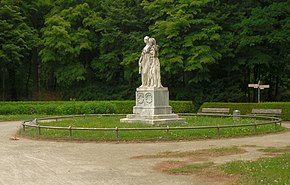Queen Monument

The Königinnendenkmal or princess monument on the edge of the Eilenriede in Hanover from the time of the German Empire at the beginning of the 20th century represents the two princesses and later queens Luise of Prussia and Friederike of Hanover . Both were in Hanover in the Old Palace opposite the Leineschloss as Daughters of the later Duke of Mecklenburg-Strelitz Karl II. Born. The sisters first became princesses of Prussia through their double wedding with Crown Prince Friedrich Wilhelm (1770–1840) and Prince Friedrich Ludwig (1773–1796) in Berlin in 1793 . A little later, from 1795 to 1797 , the sculptor Johann Gottfried Schadow created the group of princesses for the Berlin Palace . This sculpture is now an exhibit in the Alte Nationalgalerie in Berlin. Through her third marriage (from 1815) to Ernst August I , Friederike became Queen of Hanover in 1837.
After the Kingdom of Hanover was annexed by Prussia in 1866 as a result of the German-German War - which a large part of the Hanoverian citizenship did not approve - the future German Emperor Wilhelm II made Luise of Prussia on the 100th anniversary of the death of Queen Luise of Prussia and a sign of reconciliation between the House of Hohenzollern and the Welfs a present to the city of Hanover. The Berlin-based Venetian sculptor Valentino Casal created a larger-than-life copy of the Berlin princess group on behalf of the emperor . The double statue of the queens huddled together was made in Pentelic marble and about a third larger than the original: The monumental size of the copy of the classicist group of figures had a symbolic and state- propagandistic function: a Queen of Prussia and the first Queen of Hanover in brotherly and sisterly form Unity.

Postcard in collotype by Ludwig Hemmer
The imperial gift was placed on July 19, 1910 at the sharp bend in Hohenzollernstrasse, on the edge of Eilenriede and at the confluence with Yorckstrasse.
On the occasion of the unveiling of the "monument to two queens", the Hanoverian archivist Jean Lulvès received the Order of the Red Eagle, 4th class, with the crown .
After the First World War it was probably the opponents of the monarchy who “defiled” the Queen's Monument, as it was called, in the course of the November Revolution in 1918.
During the air raids on Hanover in World War II , an aerial bomb destroyed Queen Luise's head. The reconstruction by the assistant of the sculptor Ludwig Vierthaler , Erika Grindel, turned out a little too small.
With financial support from the Hanover Monastery Chamber and the help of numerous citizens as well as the Hanover Architectural Monument Foundation, the monument was cleaned and renovated in 2005, and in 2008 it received "an easily legible board with explanations." Funds for the redesign of the surrounding square were given to the Mitte district competent city district council made available.
In winter, the marble queen monument is protected with wooden cladding.
See also
- List of monuments in Hanover
- List of architectural monuments in Hanover Zoo
- List of architectural monuments in Hanover-Oststadt
Web links
Individual evidence
- ↑ a b Helmut Knocke , Hugo Thielen : Eilenriede , in Dirk Böttcher , Klaus Mlynek (ed.): Hannover. Kunst- und Kultur-Lexikon , new edition, 4th, updated and expanded edition, zu Klampen, Springe 2007, ISBN 978-3-934920-53-8 , pp. 101ff .; here: p. 103
- ↑ a b c Hans Werner Dannowski : Hanover - far from near: Out and about in city districts , Schlütersche GmbH & Co. KG publishing house and printer, 2002, ISBN 978-3877066539 , v. a. P. 21; limited preview in Google Book search
- ↑ a b c d Barbara Fleischer : Women on a leash. City walk in the footsteps of famous Hanoverian women , 2nd edition, Berlin: Lehmanns Media, 2009, ISBN 978-3-86541-273-7 , v. a. P. 32ff .; limited preview in Google Book search
- ^ Volker Werb : Schadow's group of princesses , dissertation from February 11, 1965 at the Philosophical Faculty of the University of Cologne, 1965, Cologne: Westfalen-Druckerei, p. 15; limited preview in Google Book search
- ↑ a b c Compare the text on the information board placed in front of the memorial in 2008
- ^ Reimar F. Lacher : Schadow's group of princesses. The beautiful nature , Berlin: Berlin-Story-Verlag, 2007, ISBN 978-3-929829-67-9 and ISBN 3-929829-67-3 , p. 135; limited preview in Google Book search
- ^ Hugo Thielen : Queen Monument. In: Klaus Mlynek, Waldemar R. Röhrbein (eds.) U. a .: City Lexicon Hanover . From the beginning to the present. Schlütersche, Hannover 2009, ISBN 978-3-89993-662-9 , p. 358.
- ↑ oV : Personal
- ↑ Gerhard Schneider : "... not fallen for nothing"? War memorials and the cult of the dead in Hanover (= Hannoversche Geschichtsblätter , special volume), publisher: Landeshauptstadt Hanover, Hanover: Hahnsche Buchhandlung und Verlag, 1991, p. 324; limited preview in Google Book search
- ↑ Ernst Bohlius, Wolfgang Leonhardt (Ed.): “The List.” 700 years of reviewing the village and town history , 1st edition, Norderstedt: Books on Demand, 2003, ISBN 3-8334-0276-8 , p. 25 ; limited preview in Google Book search
Coordinates: 52 ° 22 ′ 56.3 " N , 9 ° 45 ′ 25.9" E
